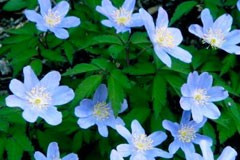- Out-of-Stock



A cultivar of nemorosa with clear blue flowers in spring. Makes a delightful pot plant, or woodland planting. Do not over-water after flowering, caution to those with irrigation systems, keep soil barely damp and not wet.
A cultivar of nemorosa with clear blue flowers in spring. Makes a delightful pot plant, or woodland planting. Do not over-water after flowering, caution to those with irrigation systems, keep soil barely damp and not wet.
Data sheet
Aquilegia caerulea cultivar, long spurred sky blue flowers with white centres, like a softer version of 'Magpie'.
Pure white flowers over fresh green fern-like foliage in spring. Useful beneath trees in semi-shade.
Old fashioned double primrose for part sun or shade in good soil. We never have many of these regretfully
Evergreen Iris from Burma, China and Japan. An attractive species with fans of leaves and light blue flowers in early summer. I find the foliage effect of this plant very useful when combined with grasses, sedums and euphorbias. Interesting large seed heads.
Still one of the most graceful cultivars with deep blue flowers edged silver.
Summer flowering perennial with brightly coloured red and yellow flowers. Extremely tough, long lasting and dry tolerant once established, likes regular clay loam or regular garden soils, doesnt like sandy soil. Combines well in meadow garden plantings amongst grasses and perennials.
Sculptural plant with large fleshy leaves from central Mexico. Great container and rock garden plant for sunny dry conditions, combine with other succulents and grasses.
A graceful low mounding grass from Japan, best in shade and good soil. Useful for foliage effect amongst other woodland plants. This is the green foliage form, deciduous in winter.
Climbing Tasmanian clematis with simple, white flowers. Dense, bushy growth and attractive olive green occasionally purple foliage. Responds well to pruning.
Pink form of Veronica longifolia, a good perennial groundcover under roses and amongst other perennials.
Perennial wallflower, winter flowering, forms a small shrub. Attracts birds and butterflies, fragrant.
The best dwarf "English" hedging lavender, which only grows to 60 cm or so. Trim after flowering to encourage bushy plants. Long-lived and not messy like other varieties.
White form of 'Catmint', effective path edging plant or combined with lavender and santolina in the cottage garden. Low growing, ground covering. Trim off dead flowers to extend flowering period.
Pink Siberian iris which combines well with white colour schemes. Useful for in-fill between roses or in the mixed border.
Pink form of Astrantia major: a good companion for hostas and dicentras in woodland.
From Georgia and the western Caucases a lovely tall herbaceous paeony with cream flowers on tall stems. A wonderful plant for cut flowers & the large leaves are most attractive. Requires good soils and a touch of lime.

A cultivar of nemorosa with clear blue flowers in spring. Makes a delightful pot plant, or woodland planting. Do not over-water after flowering, caution to those with irrigation systems, keep soil barely damp and not wet.